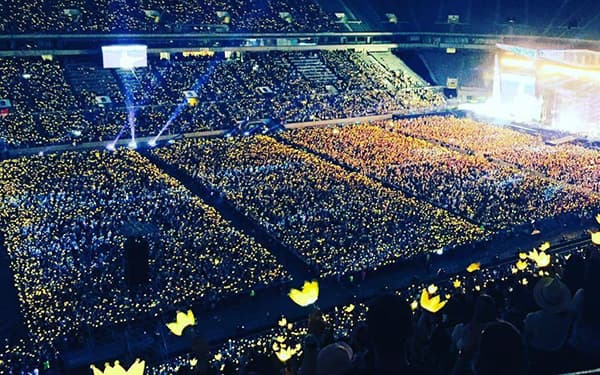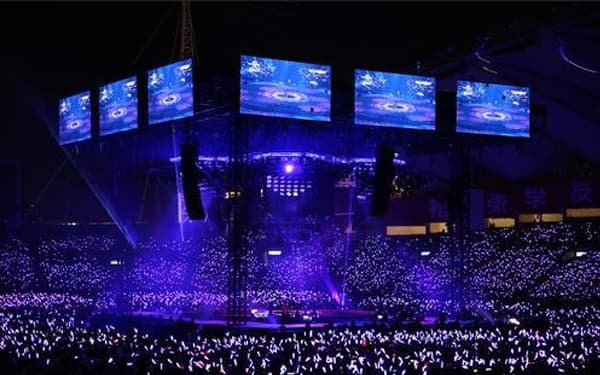How flexible LED display used for Stage: Joey Yung's Concert Event Solution?
Since the outbreak of COVID-19 in 2020, the global film industry has been in a lockout crisis, which has forced filmmakers to find ways to solve the dilemma. Among them, virtual production has not only become a hot topic but also become a film production method that many film and television creators are eager to try.
With the gradual lowering of the threshold of hardware and software technology, virtual film production will undoubtedly become more common and mature. This blog post will introduce the characteristics and application level of virtual production and share the behind-the-scenes filming of such film and television works as Sweet Home and Mandalorians, leading you to get a glimpse of the development potential of virtual production.

Virtual technology overturns the traditional production process
“Virtual Production” generally refers to the production mode that combines virtual shooting and actual shooting, from green screen, dynamic capture, to visuals preview movies, LED volumes, etc., which can be regarded as part of it.Movies like Lord of the Rings, Avatar, or Gravity have all used this technology and are foregoers of virtual production.In recent years, the popular virtual production process emphasizes the importance of preview synthesis and real-time monitoring, so that the staff can directly see the effect of the composite picture on film site.
In addition, game development software Unity, Unreal Engine, etc. have become the main force of virtual production technology. In addition to their ability to design elaborate 3D scenes, they can also create realistic animals, characters and more, creating fully animated movie worlds from scratch.” Now I can sit at home in my pajamas and direct and edit my movie on my computer and have the camera where I want it and play with all the lighting and all the textures and stuff,” said Wes Ball, who directed Labyrinth.
For traditional production, from script development, and cast film to the post-production, the production team needs to shoot in the face of the irreversible process, not only will overcome many external factors such as weather, time, and venue and let the actor, director, photography, or fine arts department of the cast, to constantly adjust their own working ways, to cope with a variety of situations.
For virtual productions, however, the set crew can switch time and space around the studio at random, and participate in the post-production phase early with the help of the virtual art department. If it is necessary to modify the script, makeup shots, etc., it is also convenient for repeated adjustment, so that the shooting process is more flexible.
Ultra-realistic LED volume wall brings immersive shooting experience
In recent years, the most eye-catching topic of virtual production is undoubtedly the LED volumes in the virtual studio. When shooting in front of an LED volume wall, the camera position can be transmitted back to the game engine in real-time via a virtual photography system (e.g. Ncam, Style RedSpy, etc.) The image content of the LED video wall is directly changed as the camera movement is used to shoot the appearance in a 3D environment.” It’s like putting VR goggles on a camera lens and letting your camera enter a virtual world,” virtual producer Amir Endalah said.
Different from the traditional green screen, the characteristics of the large size, curved surface, and wide screen of the LED video wall can create an immersive filmmaking environment for the set crew. So the set crew can more accurately finish lighting and position, and actors also no longer need to face the blank green screen to perform. The post-production team also can omit to glance back and correct the color process, which greatly improves the efficiency of filmmaking.
Even so, LED video walls still have some technical problems to overcome. As an LED volume wall is composed of a large number of LED screens, some complicated camera movement handling or shooting angles may cause color deviation or even annoying Moire pattern on the LED volume wall, which requires more effort to repair in the post-production stage. In addition, in view of the limited space in the virtual studio, if you want to use lamps or LED wall light sources to simulate the natural light of the outdoor scenes, there may be a problem of insufficient realism, which needs to be compensated by adjusting the exposure amount.
The Star Wars series, The Mandalorian is known for its big budget and big production. However, many of the spectacular and beautiful scenes were actually shot in a virtual studio with an LED volume wall.

“Our first priority is to build a virtual art department.”, Clint Spillers, director of virtual production. The department starts preparing 30 weeks before the shooting date. In addition to the cinematography director, visual effects director, set designer, and other crew members, the game industry’s art designers, modelers, and other professionals participated in the discussion and reviewed the animation simulation of the scenery, lighting, and camera operation according to the Techvis video.
In order to create realistic virtual scenes, the Virtual Asset Department (VAD) had to work with the director and art director to study the effects of the virtual camera when shooting. If the virtual scene is to imitate the real world scene, the process should be based on the photogrammetric results, precise layout of every detail.”Everything we build is designed in inches, millimeters,” Spillers stressed.
Home Sweet Home, a webcomic adaptation, is full of grotesque humanoid monsters, and one of the monsters that impress the audience is the giant “protein muscle monster”.” Protein Muscle Monster” includes scenes in which the actors perform in special makeup and costumes but also uses virtual production technology to create a bigger monster image. Live Link, a plug-in program of Unreal Engine, was used to collect dynamic capture data in advance, make 3D models of monsters, and track the track of virtual cameras. Then on the set, the virtual photography system NCam was used to monitor the interaction between virtual characters and real actors in real-time, so as to improve the speed of on-site communication.
“The ability to monitor special effects in real time saves a lot of time and resources and provides a unique collaboration between actors and directors.” visual effects supervisor Lee Byeong-Joo explains. Compared with the special effects of a traditional green screen, this technology can not only facilitate the director to arrange the actors’ position, and allow more freedom of camera shot position but also shorten the time of dimming and synthesis in the post-production, so as to effectively create the monster animation with excellent texture.
Although virtual production can not replace the charm of real shooting, it is bound to represent a new direction for future film and television production. The rise of dynamic capture, LED volume walls, real-time monitoring, and other technologies in recent years, more obviously is a revolutionary change in the film and television industry. If the technological barrier or production costs are lowered further in the future, TV dramas or independent film producers will have the opportunity to use the relevant configuration to shoot more imaginative film and television works.
Want to know more about the Audio Visual Solutions?
